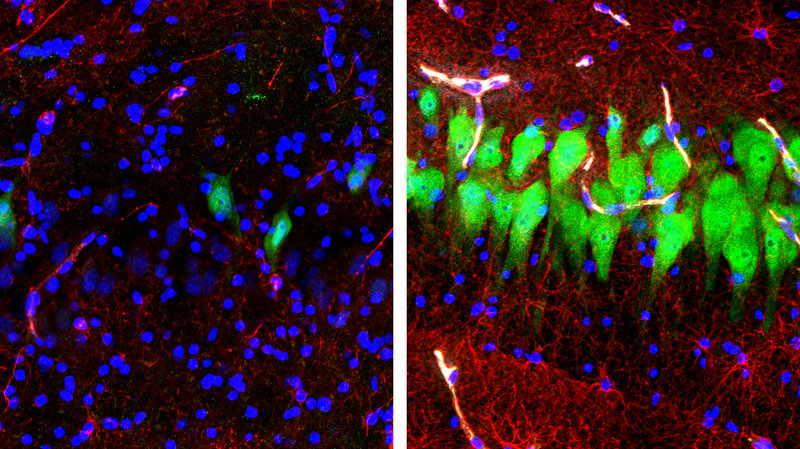The image on the left shows the brains of pigs that were untreated for 10 hours after death, with neurons appearing as green, astrocytes as red and cell nuclei as blue. The image on the right shows cells in the same area of brains that, four hours after death, were hooked up to a system that the Yale University researchers call BrainEx. Stefano G. Daniele and Zvonimir Vrselja, Sestan Laboratory, Yale School of Medicine
You guys, this is happening. And it’s not even freaky Friday!
It was just revealed that the brains of dead pigs were partially revived by scientists hours after they had been killed at a slaughterhouse.
“The Yale University research team is careful to say that none of the brains regained the kind of organized electrical activity associated with consciousness or awareness. Still, the experiment described Wednesday in the journal Nature showed that a surprising amount of cellular function was either preserved or restored.”1
Obviously, the implications of this study are staggering.
The brain is extremely sensitive to a lack of oxygen and shuts down quickly. However, researchers have known for some time that viable cells can be removed from post-mortem brains hours after death and studied in a lab dish. But, according to Nenad Sestan, a neuroscientist at the Yale School of Medicine in New Haven, Conn, “the problem is, once you do that, you are losing the 3D organization of the brain.”1
So, Sestan and colleagues, curious to study brain cells while leaving them in an intact organ so that they had all the oxygen, nutrients and various other cell-protective chemical needed, spent the past six years developing a technique. The final version of their technology is called BrainEx.
While at the slaughterhouse, researchers flushed the brains to clear out residual blood and to cool down the tissue, then,
“Back at the lab, they removed the brains from the pigs’ heads and placed the isolated brains in an experimental chamber. The researchers hooked key blood vessels up to a device that pumped in a specially formulated chemical cocktail for six hours, starting about four hours after the pigs had been killed.
These brains ended up looking dramatically different from pig brains that were left alone to deteriorate. ‘We found that tissue and cellular structure is preserved and cell death is reduced. In addition, some molecular and cellular functions were restored,’ Sestan says. ‘This is not a living brain, but it is a cellularly active brain.'”1
This approach now offers scientists a new way to study brain diseases, injuries or the basic biology of the brain- one of their original hopes and goals- not restoring consciousness to pig brains in the hope of one day restoring consciousness in humans. (The scientists constantly monitored the pig brains’ electrical activity, Latham says. If they had seen any evidence that signals associated with consciousness had emerged, they would have used anesthesia and cooling to shut that down immediately.1)
“The special solution pumped into the brains included the anti-seizure drug lamotrigine, which is known to block or dampen neuronal activity… But tests done on single cells taken from the pig brains, which involved washing off the solution, showed that individual cells were capable of electrochemical responses. So it’s unclear whether the team would have seen global electrical activity linked to consciousness in the pig brains if the neuronal-activity blocker had been left out of the treatment or if the blocker had been removed after cells had partly revived.”
Researchers have a lot of work to continue to do and so do those who govern just how far they can go. We will update you if more information becomes available.
SOURCE:












